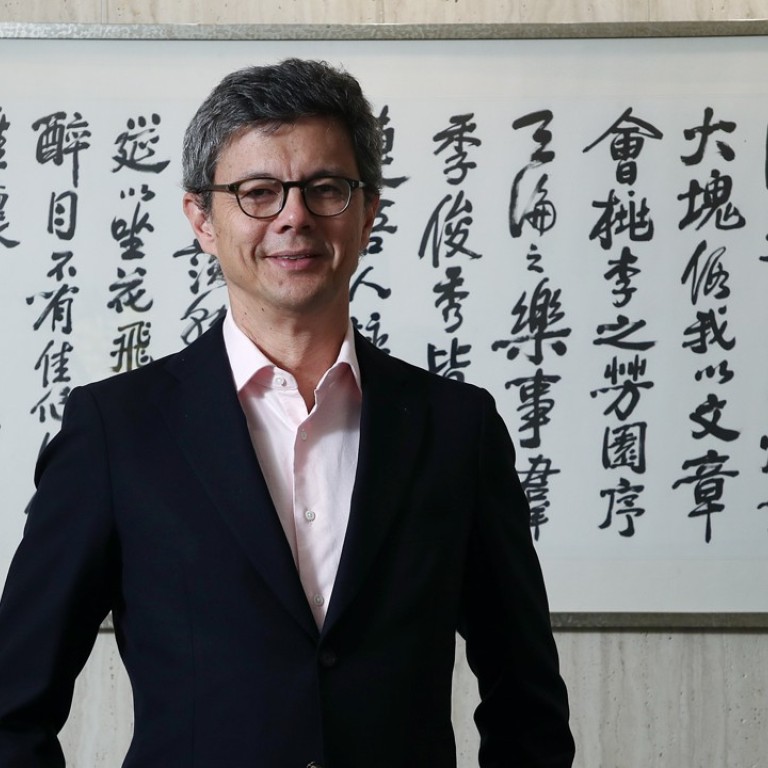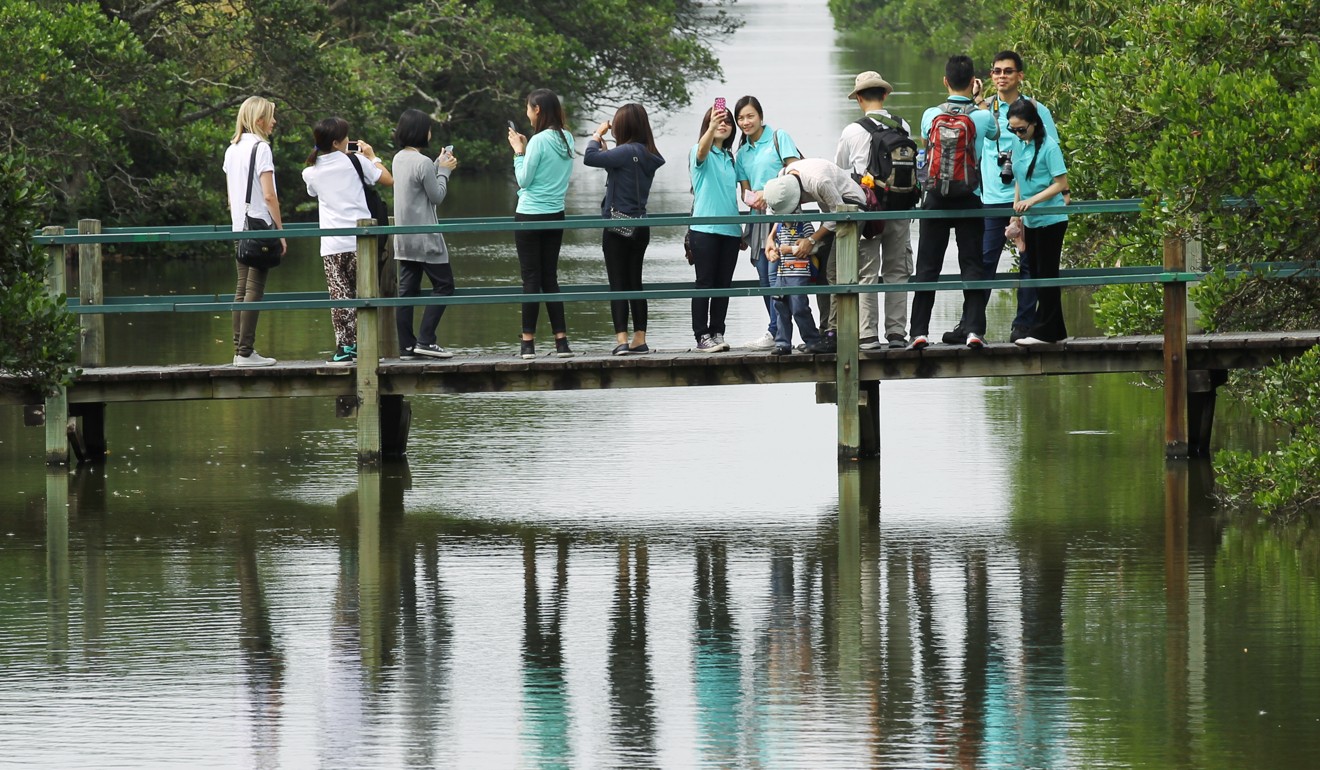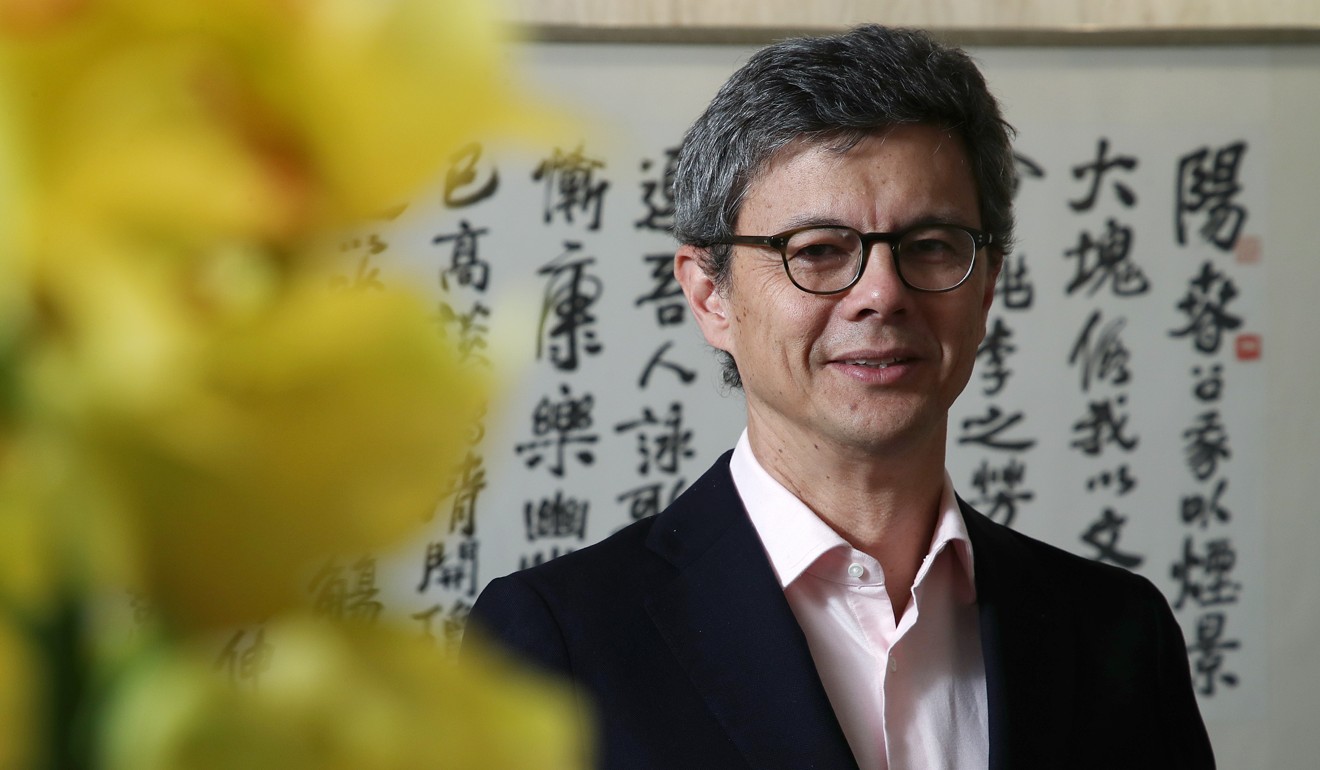
Talking the walk on turning traffic-choked Hong Kong street into pedestrian oasis
Conservationist Markus Shaw turns his attention to polluted Des Voeux Road Central with the aim of turning it into an environmentally friendly zone
Markus Shaw has worn many hats in his lifetime. The 58-year-old former lawyer turned businessman and environmental campaigner – and grandnephew of late TVB creator Sir Run Run Shaw – is now busily promoting an ambitious scheme to pedestrianise one of Hong Kong’s most crowded, polluted roads.
Despite being one of the most recognisable streets on Hong Kong Island and home to a number of iconic buildings, Des Voeux Road in Central is notorious for its traffic congestion and narrow pavements, making it difficult to traverse both on foot or via public transport.
By transforming one of Hong Kong’s main arteries into an environmentally friendly pedestrian and tram zone with just one lane of traffic for deliveries, Shaw hopes the Central business district will be revitalised too.

“The current state of Des Voeux Road Central doesn’t benefit anyone,” says Shaw, chairman of the Walk DVRC project. “It’s a horrific pedestrian experience – very unsafe because of jaywalking.
“It doesn’t benefit bus companies either because congestion is terrible, and the buses move through there at such a slow pace that you have to wait ages for them.
“It doesn’t benefit the tram company because trams are moving at slower than walking pace during rush hour.”
Hong Kong smog hits top of the health risk scale, thanks to haze and low winds
As for the likely timescale of the project, Shaw hopes to launch a three-month pedestrianised trial zone on the western section of the road by the end of this year.
After years of consultations and planning, the government’s slow uptake of the scheme has also hampered its forward momentum.
“These projects do take a while to plan. You need to come up with a proper management structure, you need to design street furniture and parts of the road you have to change,” he adds, citing the under construction Central-Wan Chai Bypass, which will ease some of the traffic congestion on Des Voeux Road.
Work to begin on Hong Kong’s historic Central Market, but no one knows what the plans are
As the former chairman of WWF Hong Kong and co-founder of urban planning NGO Designing Hong Kong, Shaw is no stranger to campaigning for citywide change.
His lifelong passion for protecting the natural environment, nurtured from childhood, has developed into a wider interest in the built environment, with the end goal of transforming Hong Kong into a world-class modern city through sustainable, citizen-friendly urban planning.
You went to school in the UK but grew up in Hong Kong. What can Hong Kong learn from cities in Britain and Europe?
I know England very well because I worked there for a while and went to school there, but I really consider myself to be a Hongkonger. I was born in London but came back here at six weeks old.
Many European cities went through what Hong Kong is going through now. Many of them moved from old, pedestrian-friendly neighbourhoods to car-focused transport policies, but they realised that that was unsustainable and a dead end. So now they’re moving back into cycle-friendly, pedestrian-friendly transport solutions and in that sense, they are ahead of us.
Our vehicle fleet is growing by 4 per cent per year. That is huge! How can we possibly build enough roads to keep up with that growth?
That’s a direction in which I feel Hong Kong should be going and I’m convinced will be going, because more and more people will see and understand that our current car-focused transport policy is unsustainable.
Our vehicle fleet is growing by 4 per cent per year. That is huge! How can we possibly build enough roads to keep up with that growth?
When I first went to China in the early ’80s, most of the cities were bicycle-focused. Now they have become car-focused cities and they are experiencing all the problems that come with that: congestion, pollution and destruction of old neighbourhoods. I’m sure they will be moving back to pedestrian-focused, bicycle-focused city planning as well. It’s inevitable.
We are always late to the game with everything in Hong Kong. We are a city of eight million people – we have more people and more talent than many European countries. Why should we be falling behind in so many of these areas? We should be showing the world how to go.
What inspired you to leave a law career and become an environmentalist?
I had a few very good years in the law, where I started, but I never hugely enjoyed it. I blame my parents for [making me passionate about the environment]. When I was young, they would take me hiking, to picnics, and I developed a real love for the countryside and nature. I think that all conservationists are nature lovers at heart.
When I was with WWF, I always said that you can teach conservation in a classroom until you’re blue in the face, but one afternoon in Mai Po [Nature Reserve] can change your life.
How have Hongkongers’ attitudes to the environment changed in the last few decades?
Immensely. When I first started out as a nature conservationist, it was a niche concern in Hong Kong. So was the urban environment. Today, it’s become really part of civic society because of a greater sense of citizenship on the part of Hong Kong people – a greater sense of ownership of our city. People are willing to take more responsibility for the environment.

The government is maybe slower to change in the way that civic society can. But civic society can definitely be an active force for good. It seems that most of the initiatives for change start in Hong Kong civic society, and that’s a wonderful thing to say about us. That makes me really proud to be a Hong Kong person.
What makes Hong Kong’s urban environment so unique, and is this under threat?
What’s unique about us is that 40 per cent of our poultion lives above the 16th floor. Because of that urban density, there are two advantages I can think of. Firstly, it enables connectivity, so we don’t have urban sprawl like Los Angeles where you have to drive everywhere. Secondly, it enables us to set aside over 40 per cent of our land area as country park.
You have no idea how unique we are in being able to access real wilderness within 15-20 minutes of wherever we live in Hong Kong. I’m not talking about Hyde Park or Central Park, but real wilderness. That’s really exciting.

I think any great city needs a sense of self-confidence, otherwise why would Athens, for example, have generated such great men in ancient times with only 40,000 citizens? It was sheer gumption. I think we need projects like Walk DVRC to show the community that we can do it.
People complain all the time that Hong Kong is losing its competitiveness. Yes and no. What I think people here are losing is their self-confidence, because we cannot seem to deliver big projects like Walk DVRC. It’ll be great for Hong Kong!
What’s your ideal vision for Hong Kong?
I can tell you what it’s not. People keep on comparing us to cities in the Pearl River Delta and in China, which are making big strides in infrastructure and so on. We don’t need to go there any more because we have the infrastructure already.
It’s not unreasonable for me to suggest that the government should plan the cities in a way that the people want the city to be – not according to what they think is best.
I think Hong Kong people today have a vision of Hong Kong that is more focused on quality of life, and the urban and natural environment. It’s these kinds of cities that attract talent from around the world. Because we are very much higher along the economic chain of development in Hong Kong, we need that talent.
What’s your response to sceptics of the project?
Don’t be silly! [Laughs] Plan differently, take more time if you have to. For example, with Site 3 down by the harbourfront, that must be the most exciting green field site in the whole world. It’s right by one of the world’s two great iconic harbours. We should plan something that will remain there in 1,000 years. Not something that we’ll make do with, because that’s how they’ve always done it.
Look at Venice. They really plan for 1,000 years! We should not plan for tourists here in Hong Kong. Instead, plan for citizens, make a beautiful city, and the tourists will come. And that’s what Walk DVRC is about – returning the street to citizens, making a beautiful Central business district, and tourists will come to see that.
What’s the most memorable place you’ve travelled to?
I went on a four-day safari by canoe down the Zambezi river in Zimbabwe, without firearms or the ability to make a fire. In the evenings, we basically stuck a rudder on the sandbank, put mosquito nets over us, and in the mornings elephants would walk through our camp. It was the most staggering experience – the most amazing four days of my life.
What’s your favourite place in Hong Kong?
Home. [Laughs] Apart from that, there is a particular spot in Sai Kung East Country Park that’s quite difficult to get to, but you can look over to a huge bluff that goes out onto the sea. It’s a bit windswept, but I love being there.

What was your dream job as a child?
I wanted to be a marine biologist. That’s why, when I was chair of WWF in Hong Kong, my focus was on marine conservation.
What hobbies do you do in your spare time?
Photography is a big one. Reading, listening to music and watching movies.

What books do you like to read?
I read a lot of history. I tend to focus on non-fiction writing, and today’s the golden age of history writing. Any fiction that is written before the second world war. I recently read a wonderful biography of St Augustine by Peter Brown, who’s a great historian of the Roman Empire.
What’s your favourite food or cuisine?
Any form of comfort food. Pasta, clay pot rice, dumplings, bread, olives, honey!

